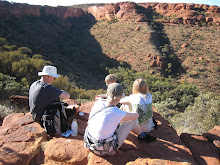
I'm sure many people imagine we spend much of our time traveling with children looking for zoos, amusement parks and ice cream cones. Actually, we have never been to a zoo abroad (we have a fine one at home), only one amusement park (the historic Tivoli Gardens in Copenhagen - we never even told them there was a Disney near Paris) and at best, only one ice cream treat every few days. We try to avoid feeding into the stereotype that children must be interested only in child-like things and adults interested only in serious things.
Once children pass the toddler stage, they are capable of enjoying what you enjoy, as long as you take it in small doses. We see a lot of museums, but rarely for more than an hour for a small one or 2 hours for a large one. We see a lot of castles and cathedrals, but they are usually less than a 2-hour visit as well. If there is a good hands-on museum or science center, we try to go there so the children can explore and touch. When in cities, we look for parks so the children can run a little and be silly. Occasionally, we even find a interesting playground and that becomes a just-for-kids sort of stop.
But for the most part, we try to get some shared enjoyment out of the same things. It would be awkward, at best, to have to travel in a group and to completely dislike certain kinds of stops. We aren't interested in fancy dinners, nights at the opera, or any other chic events that would be inappropriate for children. The one thing the children won't do is go for aimless long walks. That is beyond their ability to appreciate and would zap their much-needed energy level. So whenever it seems appropriate to do so, we let the children stay back in our hotel, B&B or cottage and go for an evening walk ourselves. It lets us explore a little and gives everyone a break from each other.
The biggest challenge for the children are souvenir shops and learning the hard lesson that you can't have one of everything you see. We give each child a spending limit of $100 for souvenirs with the understanding that any amount left over at the end they will get to keep as cash to put in the bank. The biggest temptation then is to stop at the first shop we see and buy the first interesting object we see, instead of waiting for that truly special item that might (or might not) come later. Since we pack light, all souvenirs must be light, small, and not fragile, too. In the beginning, the children were very impulsive shoppers. They have grown into much more discerning shoppers with each successive trip. That is a valuable lesson in itself.
We try to make each trip an educational experience. We talk about language and customs. We talk about the history of a place and how it relates to that of it's neighbors. Seeing the major museums also helps to put a place's history in context. When a place offers a unique learning experience (like WWII, Nazi Germany, Anne Frank and the death camps at Auschwitz we will see on this trip), we try to connect the dots for the children, explaining how one action led to another. In the end, we hope the children come away from the experience with a greater understanding of how history comes together, how societies evolve, and how they are similar and different from one another. But we try to have fun, too.
The most important point I would like to emphasize though, is that the things we do are largely the same whether the children were with us or not. As adults, we don't feel like we are sacrificing anything by having the children with us. If anything, seeing things through their eyes as well as our own makes us appreciate the experience even more...


No comments:
Post a Comment